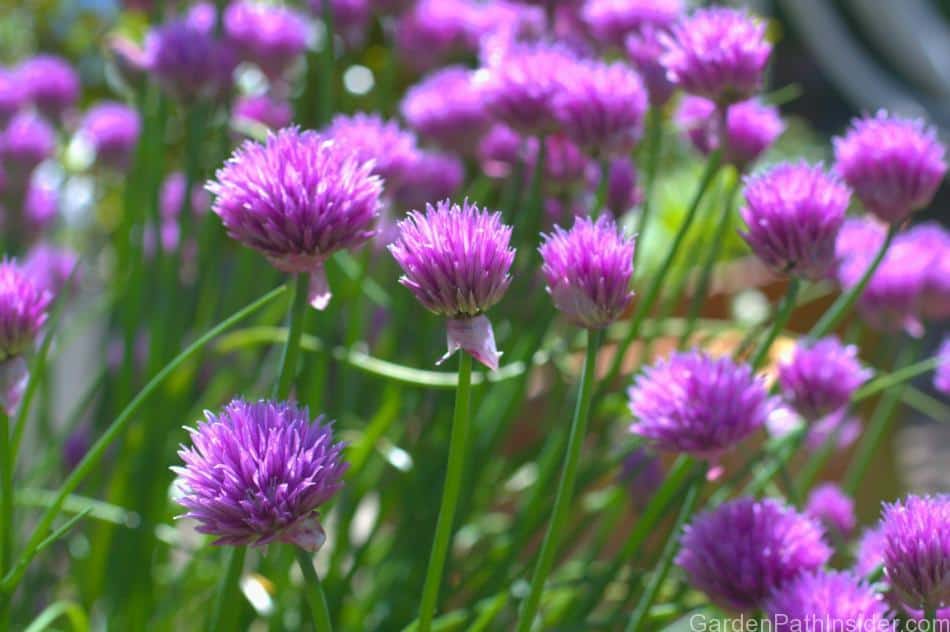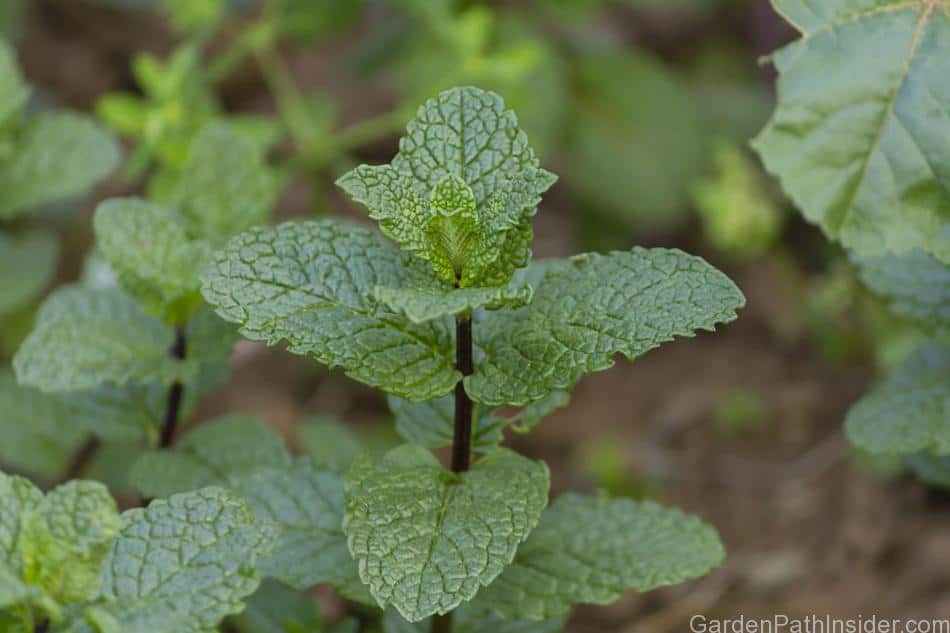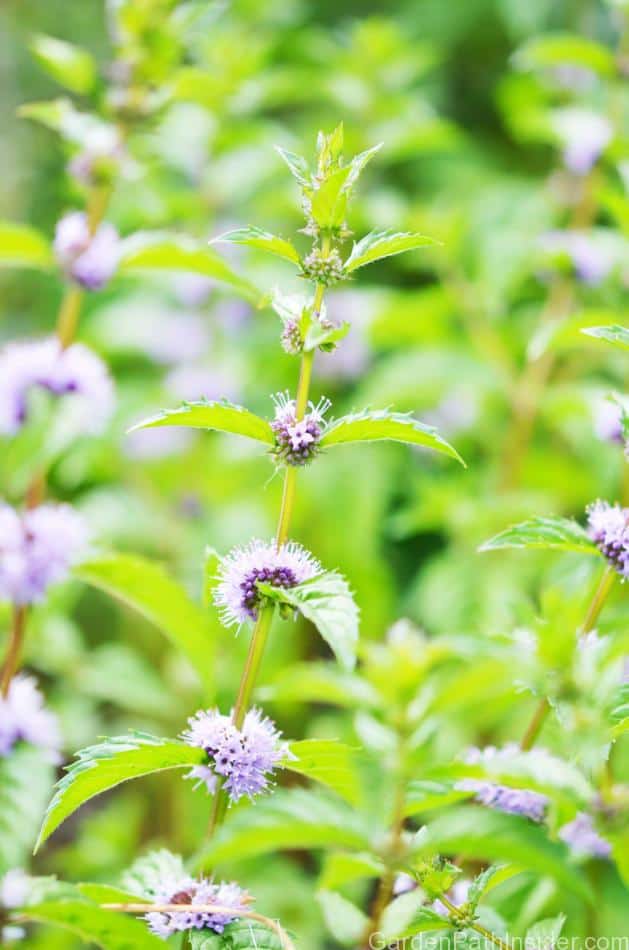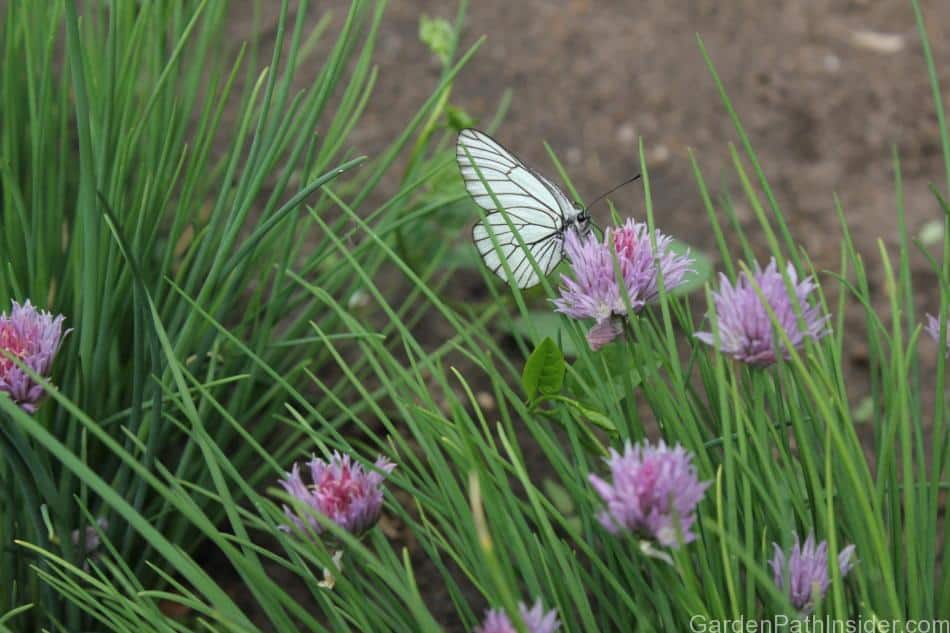
Mint and chives are edible culinary herbs used in foods and beverages. These herbs are easy to grow in small counter-top herb gardens or vast backyard garden beds.
Mint and chives should not be planted together as mint is an invasive species and will quickly overtake any growing space. Mint and chives are excellent companion plants to grow next to each other in separate containers, as both herbs require the same light and water needs. Mint also repels pests that could damage the chives.
Mint and chives are great additions to any herb garden, and if these herbs are grown in pots, they can be brought indoors through the cold months for a fresh herb harvest year-round.
Overview of Mint

Mint is a quick-growing herbaceous perennial, grown for its edible leaves. Mint leaves are used in beverages and treats. There are many varieties of mint, each with its own flavor and fragrance. The sweet spearmint and peppermint are great additions to teas and desserts.
Some of the lesser-known mint varieties are apple mint, pineapple mint, and chocolate mint. The different varieties of mint should not be planted together as they will lose their unique flavors and fragrances when grown in close proximity.
Overview of Chives
Chives are perennial herbs that grow in bushy grass-like mounts. The individual blades of chive are the edible harvest of this herb. The flavor of chives tastes similar to onions though milder. Chives are a great addition to savory meals and are used in dishes with meats, fish, poultry, and vegetables like mashed potatoes.
Chives can be easily grown from seeds or propagated from small plants, both can be purchased online or at your local home good store. Chives can be harvested continuously through the season, and chives potted indoors can be grown and harvested year-round.
Container & Growing Space Requirements
Mint is best grown in a container or raised garden bed. Mint is an invasive species and should be grown in a contained area. If left to grow free, mint could easily overtake a full garden bed in a season or two.
Mint roots grow down about 8 inches (20cm), though the mints runner roots called rhizomes will grow outward horizontally continuously throughout the growing season.
Once mint roots take over an area of your garden, it becomes a full-time job to completely eradicate the mint patch during the growing season. Any roots that are missed and not removed will return to the garden the following spring and continue growing.
Garden bed barriers are often used when planting mint in a garden bed with other plant species. The garden bed barrier is buried below the surface of the soil in a perimeter around the mint patch. The barrier helps to contain the mint from spreading and overtaking the garden.
Chives thrive in moist fertile soil that is well-draining. Growing chives in a container are my preferred method, instead of planting chives directly in the ground. By using a container, you can move the chives around the garden as needed as sunlight hours diminish later in the season.
Also, Potted chives can be brought in during the winter. Chives grown indoors can be grown and harvested continuously year-round. This is a great fresh herb to keep in the kitchen.
Clay pots are my first choice when potting any plant. The clay pots are porous enough to let excess water seep through the pot out of the soil.
Chives can grow in any size pot, though it thrives with ample space between each chive plant. Chives do not spread as rapidly as mint, and so a growing container 8 to 12 inches (20cm to 30cm) in diameter is perfect for most indoor container gardens.
Soil Needs for Mint and Chives

Mint can grow in many types of soil as it is a quick-spreading invasive species. However, mint that is grown intentionally for culinary consumption should be grown in fertile well-draining soil. A high-quality potting soil will provide the nutrients needed to maximize the growth and flavor of your mint patch harvest.
When planting mint in a raised garden bed or container, look for a potting soil blended specifically for herbs and vegetables. If you are growing mint in a garden bed, I recommend using fertilizer once each year at the beginning of the growing season.
Chives grow best in moist fertile soil that is well-draining. I recommend planting chives in a pot that can be moved indoors during the winter months.
Start with a high-quality nutrient-rich potting mix designed for vegetables and herbs. These potting mixes will provide a sustained nutrient release to the chives and help deliver the most flavorful herbs come harvest.
Chives are also quite easy to start from seeds, and only involves a few steps to start a new chive container garden.
Start with a potting soil designed for starting seeds. This seed starting mix will be a great sterile base to propagate chive seeds.
- Fill your pot with seed starting soil, then thoroughly water the soil. This technique is used when starting seed propagation. Watering the soil before the seeds are sown will keep the seeds from washing away once the water is added.
- After the soil is watered, sprinkle the chive seeds around the pot. Leave space between seeds for the plants to grow and develop. Sprinkle a thin layer of soil over the seeds once laid.
- Incubation period: Place the pot of chives in a plastic bag that fully covers the top of the pot. Plastic kitchen wrap can also be used to tightly cover the top of the pot. Covering the pot will keep the moisture in the soil and provide the perfect growing environment for the seedlings.
- Place in a warm location for one to two weeks. Once the seeds have sprouted you can leave the pot uncovered and in a window that gets full sun.
Water Needs for Mint and Chives
Mint Water Needs
Mint roots will spread quickly and continuously during the growing season, and a thriving mint patch will require frequent watering. Keep the soil moist for mint by checking daily for the signs of dehydration.
Signs of dehydration in mint:
1: Dry Soil: Gently touch the soil to gauge the moisture levels of the plant. Water once the soil is noticeably dry to the touch. For larger gardens, a soil moisture meter helps to reduce overwatering sensitive plants.
Extremely dry soil in a pot will begin to pull away from the sides of the pot. If the soil gets this dry with a mint plant, then the plant will already be giving off signs of extreme dehydration like mass wilting.
2: Wilted leaves: Wilted dry leaves means your plant urgently needs water. Wilted leaves that are wilted and feel kind of soggy are likely the result of overwatering, or the mint plant is sitting in standing water. If that is the case, quickly work to drain the container or garden bed of the excess water.
3. Drooping stems: Drooping stems are a clear indication of dehydration in mint plants, luckily mint perks back up as soon as it is watered. Look at the new growth on the tips of each stem, the new green growth will be visibly drooping to one side. A thorough watering will bring the new growth back aligned.
Chives Water Needs

Chives need to be watered frequently and thoroughly. Check the soil moisture levels daily and water until the root balls have been completely saturated.
If the chives are being grown in a container, bring the container to a deep sink and water the plants thoroughly until water begins to flow through the bottom of the pot. Leave the chives in the sink overnight to drain.
Signs of dehydration in chives include drooping stems and withered looking blades of chives. When the chive blades begin to look shriveled the plant needs water.
Light Needs for Mint and Chives
Mint and chives both thrive in full sun 6 to 8 hours per day. Both herbs will grow with less than full sun, though the plants development will be weaker and slower when grown in partial shade. Be mindful to keep indoor potted plants away from direct heat sources like space heaters, hot air ducts, and stoves/ovens.
Harvest Time for Mint and Chives
Mint leaves can be harvested and eaten at any stage of the leaf, though it is recommended to wait until the leaves have reached maturity in flavor and fullness.
To harvest mint, use a sharp pair of scissors to remove the leaves as close to the stem as possible. If the stem is broken or damaged during mint harvest, the stem can be placed in a glass of water and will live on indoors and can be harvested as needed.
Chives planted outdoors can be harvested repeatedly through summer and early fall. Chives grown indoors can be grown and harvested year-round.
Chives grow in clusters and the individual chive stems look like large blades of grass. When the chive blades are harvested, they will regrow like grass and will be ready to harvest again in a few weeks.
To harvest chives, grab a handful of the chive stems, and cut the cluster off the plant with a sharp pair of scissors. Leave about 2 inches (5cm) of the plant so the stems can regrow for another harvest.
Summary Chart for Mint and Chives
| Plant | Soil type | Water needs | Light needs | Bloom time | Harvest time |
| Mint | Loose well-draining fertile soil | Water as needed to maintain moist soil. | Full sun(6 to 8 hours per day) | Spring/Summer | The best practice is to wait until the plant grows to around 6 inches tall (15cm) before harvesting, though mint leaves are edible at any time. |
| Chives | Loose well-draining fertile soil | Keep the soil slightly damp to moist. Water as needed. | Full sun(6 to 8 hours per day) | June to early fall. | Outdoor harvest: June to early fall. Indoor harvest: Year-round |
Cover image: Purple chives blossom_© julietphotography/123rf.com
